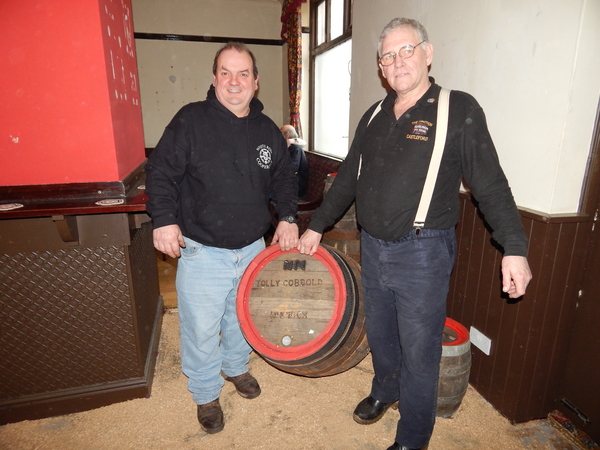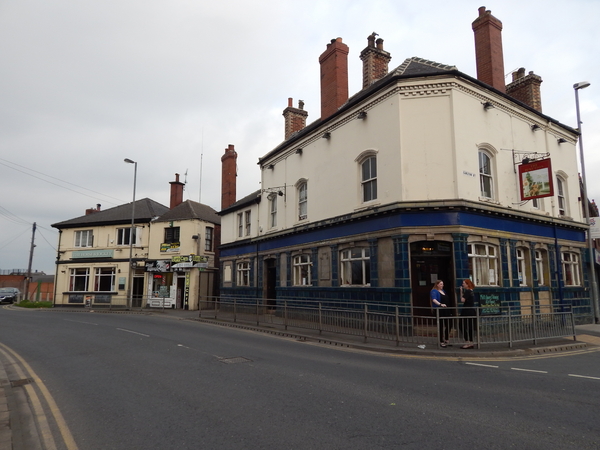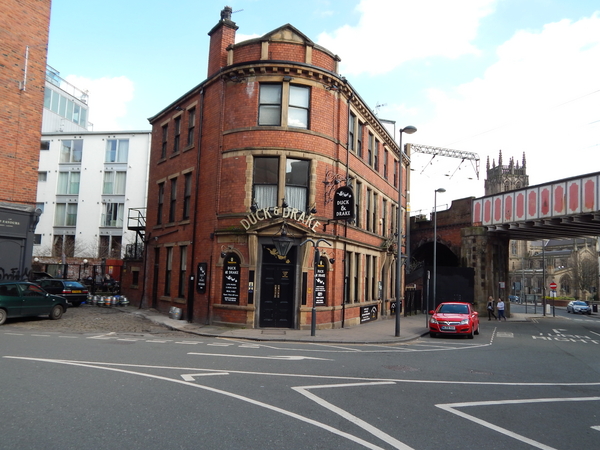'Woodies' on the rise in Yorkshire
Added: Friday, April 10th 2015

One spark can cause a blaze. At the Junction pub in Castleford, West Yorkshire, Neil Midgley’s passion for “beer from the wood” has led to brewers and other publicans picking up the torch he lit and are using oak casks to age and serve beer.
The Junction was a run-down pub until Neil and his partner Maureen Shaw took it over. It had become a feeder pub for a local night club but Neil and Maureen lovingly restored it. Neil is a carpenter by trade. He loves working with wood and laid parquet floors in the Junction and designed a wood-panelled snug.
Beer from the wood was a logical next move for Neil. He had the good fortune to meet up with Alastair Simms, a master cooper who had worked for Wadworth’s in Devizes and now runs the White Rose Cooperage in Wetherby in Yorkshire. Alastair (pictured left above) supplies Neil with oak casks that Neil takes to brewers to fill with beer: his travels have taken him as far as the Chiltern Brewery near Aylesbury in Buckinghamshire.
The Junction revolution is spreading...by a few yards. To complement the nine beers on handpump in the Junction, Neil and Maureen have bought the neighbouring Horse & Jockey pub and extended their support for oak-aged beers. The two pubs(pictured below) are separated by a barber’s shop. The H&J was once the leading pub in Castleford, a Tetley outlet, but it’s been closed for several years.
It’s now become a Mecca for oak-aged beer. The floors are covered in oak chips—to emphasise the pub’s commitment to wood -- and the main bar is stacked with oak casks filled with beers from near and far. Over the Easter weekend, Neil and Maureen had organised a “woodfest” of beers and the centrepiece was one ale – Kirkstall Imperial Porter – served from three casks.
One came from the French wine industry, the second from a malt whisky distillery on the Isle of Skye, and the third came from an American producer of Bourbon whiskey. The brewery in Leeds gives the porter a hefty 7.9%, a strength designed to compete with the powerful flavours locked in the wood of the oak casks.
The beer served from the French wine cask had a pronounced oak and vanilla nose, followed by a dry, woody palate with burnt fruit, sweet malt and spicy hops. Chocolate and coffee made an appearance in the bittersweet finish, with notes of oak, vanilla, spicy hops and dark fruit.
The beer from the Scotch whisky cask had a tangy seaweed nose, with an acidic note and sharp tangy hops and rich malt notes. The beer was tart and acidic in the mouth with dark sultana and raisin fruit and wood notes. The finish was dry with oak and vanilla to the fore but balanced by hop resins and dark fruit.
The Bourbon cask delivered the sweet vanilla note that is the hallmark of the whiskey. The aroma also offered chocolate and coffee while the palate was rich with dark malt, vanilla, toasted wood and spicy hops. The bittersweet finish had more oak and vanilla notes with chocolate, coffee and tangy hops and finally ended dry and woody.
I preferred the middle sample from the Scotch whisky cask but I was struck by the profound differences between the three versions. I was not alone in my fascination with the experiment: the Horse & Jockey was packed to the rafters and there was an equally large and appreciative crowd supping in the Junction.
Things can only get better – and bigger. Alastair Simms has found a 36-gallon oak cask built for the Tolly Cobbold brewery in Ipswich in 1947. It will be the biggest cask Neil has used and his pleasant task will be to decide which brewery’s beer will christen the container.

Alastair and Neil plan to install a micro-brewery in the Horse & Jockey. True to style, they are looking for a wooden mash tun and fermenters and are keen to hear from any breweries with suitable kit for sale. Once in place, Neil will invite brewers to visit Castleford and brew special ales that will be served from oak casks in his two pubs.
Alastair Simms says he’s never been busier. He has taken on an apprentice to help cope with the demand for oak casks and he has just finished installing a mighty vessel for Greene King that can hold 5,500 gallons. The Bury St Edmunds brewery needs the cask to age its Strong Country Ale, a blend of two beers, one of which is held in wood for a year or more.
At the Duck & Drake in Kirkgate in Leeds (below), landlord Andy Yuill shares Neil Midgley’s love of beer from the wood. Any calls the oak casks “woodies” and stages regular events, often in association with local members of the Society for the Preservation of Beers from the Wood. The imposing redbrick Victorian pub stands alongside a railway bridge, with Leeds central station close by. It has two large bars and is a shrine to rock and jazz, with the walls decorated with drawings of the likes of Elvis and Miles Davis. One bar has a stage where local groups perform.
Andy Yuill had accepted my challenge to sample a few beers served from both oak and metal to see if there is any definable difference.
Four beers were available to taste: Osset Exclesior (5.2%), York Centurion’s Ghost (5.4%), Saltaire Cascade (4.8%) and Ridgeside Desert Aire (4.8%). Excelsior has a big hit of Cascade citrus hops on aroma and palate. The version from oak was definably different: softer and creamier with a vanilla note from the wood.
Centurion’s Ghost is a dark ruby ale and both versions of the beer offered chocolate and coffee notes on aroma and palate. The oak version has pronounced wood notes and more subtle hint of vanilla, which was masked to some extent by the rich and dark malt character of the beer.
Saltaire Cascade has a pronounced herbal, fruity and spicy hop aroma. The oak added fresh pine wood notes while both versions had leafy hops and biscuit malt in the mouth and finish. In sharp contrast to Excelsior, the version from a metal cask was softer and smoother than the oak version.
Ridgeside, a local Leeds brewery, produces Desert Aire with Amarillo, Centennial and Simcoe hops, with a small amount of Munich malt blended with pale. Both versions burst with ripe malt and citrus hops but the beer from the wood had deep notes of fresh wood and vanilla, and was notably creamier than the metal version.
There’s no doubt that wood adds an extra dimension to beer – and that dimension is deepened when oak casks that have previously held wine or whisky are used. “Woodies” may never be a national phenomenon but in Yorkshire they are creating great interest and debate and – importantly – getting people back into pubs.







